The Bible is a definitive record of law, order, government, and standard for man. It is the guideline for Christianity, and the Old Testament for Judaism. It has been noted that approximately seventy-one percent of the Bible is about government. Moses was the governor of Israel. He wrote the first five books of the Old Testament: Genesis, Exodus, Leviticus, Numbers, and Deuteronomy. At the time Moses was governor, Aaron was the High Priest and head of the church, and his brother.
Joshua succeeded Moses as governor of Israel, and after him, the Judges ruled in Israel. The rulers of that time and their kingdoms applied and followed the Judges system of government. God was their King.
Saul was the first king and Zedekiah the last of Israel. For centuries they ruled. Their history is recorded in I Kings, II Kings, I Chronicles, and II Chronicles. Many times, it was bloody, and violent, and fraught with chaos.
Psalms, Proverbs, Ecclesiastes, and The Song of Solomon were written by kings: David and Solomon. In the books of Ezra and Nehemiah lay the record of the restoration of the Israelite government in Palestine. Almost half of the Bible is written by men in government, is about civil rule and rulers, or is about the history of national governments.
But, during the rule of the Judges, God’s law was the law. God’s law was the original law. For many, it is the only law. (From the Encyclopedia of World History: Ten Commandments)
It is said of the Jefferson implementation, that government shall not establish religion or be involved in the dictation or establishment of religion. I think that it should, at the very least, qualify and clarify to position on the foundation of the United States regarding the founding principles and religion, and it should declare that our law is based on God’s law.
In the US House of Representatives, a resolution titled ‘Defense Act of 2003’, in the 108th Congress, and numbered H.R. 2045, has been sponsored by Alabama Congressman Robert Aderholt, Alabama Fourth Congressional District. It was introduced in The House on May 9,2003. It would give the right and permit by law, cities and states to display The Ten Commandments anywhere. On June 25th, the Bill was referred to the Subcommittee on the Constitution. There has been no further action taken.
Many areas of American tradition have come under fire due to the opposing views on the separation of church and state. A few examples, some quotes from some notable figures, and information on monuments follows.
The Pledge of Allegiance:
The original Pledge was written by Francis Bellamy, who passed away in 1931 and was a Baptist minister.
In the early 1920’s, the National Flag Conference, under the leadership of the American Legion and the Daughters of the American Revolution, changed the words 'my Flag,' to 'the Flag of the United States of America.'
In 1954, Congress, after a campaign by the Knights of Columbus to present the United States as separate and apart from communism during the Cold War, added the words 'under God,' to the Pledge. It was signed into law by President Dwight D. Eisenhower, who was born in Denison, Texas. At that point, the Pledge of Allegiance became both a patriotic oath and a public prayer. It was America’s recognition of her roots.
In June, 2002, Judge Goodwin of the 9th Circuit Court of Appeals in California ruled that the Pledge of Allegiance was unconstitutional. Part of the basis of the argument for the plaintiff, an alleged atheist physician from California, was the Supreme Court ruling of June 17, 1963, which opined that local governments could not require recitation from the Bible or prayers in the public schools. The physician had claimed that his daughter had to suffer through the reading and reciting of the Pledge of Allegiance in the classroom. Upon further inspection, and discussion with the child’s mother, it was reported that the child had no challenge to the incidents upon which her father brought suit. The issue has now been filed with the Supreme Court in request that it be overturned, the last update on the docket dating August 18, 2003. The ruling of the 9th impacts over nine million school children in Alaska, Arizona, California, Hawaii, Idaho, Montana, Nevada, Oregon, and Washington state.
Red Skelton had a most impressive recall of his childhood memories of the Pledge of Allegiance, and the rendition by a teacher. It is worth hearing, or reading at the link offered here.
Presidents have been quoted:
President James Madison (1751-1836)
4th President of the United States and Chief Architect of the Constitution
"We have staked the whole of all our political institutions upon the capacity of mankind for self-government, upon the capacity of each and all of us to govern ourselves, to control ourselves, to sustain ourselves according to the Ten Commandments of God."
Abraham Lincoln, Speech at Gettysburg, Nov. 19, 1863
“That this nation, under God, shall have a new birth of freedom, and that government of the people, by the people, for the people, shall not perish from the earth. “
(It is said that Lincoln coined the phrase ‘under God’.)
Ronald Reagan, Speech, March 8, 1983
“Freedom prospers when religion is vibrant and the rule of law under God is acknowledged.”
Supreme Court Justices have stated:
Justice David Joseph Brewer
U.S. Supreme Court Justice
- "The American nation from its first settlement at Jamestown to this hour is based upon and permeated by the principles of the Bible."
Justice James Iredell
U.S. Supreme Court Justice
- "I think the Christian religion is a Divine institution; and I pray to God that I may never forget the precepts of His religion or suffer the appearance of an inconsistency in my principle and practice.”
Justice Joseph Story
U.S. Congressman & U.S. Supreme Court Justice
-"There is not a truth to be gathered from history more certain, or more momentous, than this: that civil liberty cannot long be separated from religious liberty without danger, and ultimately without destruction to both. Wherever religious liberty exists, it will, first or last, bring in and establish political liberty."
Justice William Strong
U.S. Supreme Court Justice
One of the most respected justices of the 19th-century Court
- "You ask me what I think of Christ? He is the Chiefest among ten thousand, and altogether lovely my Lord, my Saviour, and my God. What do I think of the Bible? It is the infallible Word of God, a light erected all along the shores of time to warn against the rocks and breakers, and to show the only way to harbor of eternal rest."
Justice James Wilson
A signer of the Constitution and an original Justice on the U.S. Supreme Court
- "Human law must rest its authority ultimately upon the authority of that law which is divine....Far from being rivals or enemies, religion and law are twin sisters, friends, and mutual assistants. Indeed, these two sciences run into each other."
In the end of Judges, there was recognition, by Aaron, of the lack of a king. The last verse of Judges was depicted by Matthew Henry as “A repetition of the cause of these confusions” where in Judges 21:25 says “In those days there was no king in Israel: every man did that which was right in his own eyes.”
This is America. The nation that was founded on liberty and freedom. Our founding father’s believed in God, worshipped God, praised and heralded God, and included God as a part of this nation’s foundation. If you are not of the same persuasion as to join in these traditions, you have that right in America. You can practice, worship, herald, and/or praise just about anything you want in America.
But, this is America, and she and her people are entitled to establish, maintain, and protect her traditions and foundations, including the recognition of God as a part of all that she is and stands for.
Most of the controversies, it seems, arise from a public school perspective. If it is a tradition for our nation, and the foundation of our being, it should be taught in public schools in America. If someone doesn’t like what is being taught in public schools in America, there are other methods of educating a child. If someone would simply and authoritatively put their foot down and make it so, children in this nation would not be so confused about who we are and what we stand for. Come to think of it, neither would many of the adults.
For me, and I am entitled to my opinion, I believe that Judge Roy Moore will succeed in his efforts to allow the monument depicting the Ten Commandments to stand. There are laws and rulings with varying positions on the issue, and Alabama is the state in which this particular controversy will be decided, so we shall see.
The Ten Commandments are the original law from God to man. They are, without a doubt, the simplest and most explicit law ever written. They are, for anyone who cares to, the easiest to understand, uphold, abide, and share. Moses, holding the Ten Commandments, is not just depicted in the adornment of the United States Supreme Court entry, they champion the peak of the presentation whereby every other representation of law cascades from that point. To me, that represents original law - for this nation.
A report said that the original court order reflected justice perspectives that this monument depicted a podium with a Bible atop it, and that was the reason that it was ruled that it should be removed. It has been written that for any decalogue to survive a constitutional challenge, a court must find that it has a "secular purpose" and that a "reasonable observer" would not view its "primary effect" as "endorsing religion." I think the granite was a chunk of a mountain, and it looked to me that the top was a presentation of rough ground where the tablets were laid – perhaps in admiration by Moses after their inscriptions. At any rate, the order is here. Judge for yourself.
Last year, Attorney General Ashcroft spent over $8,000 covering the naked breast of the ‘Spirit of Justice’ statue at the Justice Department. (She hasn’t been removed to my knowledge.) At her feet – the Ten Commandments. I wonder who commissioned her existence in form and who approved her setting?
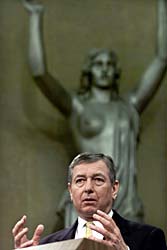
Even if though the Alabama monument has been taken out of the Rotunda and put in the closet, this has been done according to court order. Even if they sanction or disrobe Judge Moore according to ethics standards, even if protestors are radical and are making fools of themselves over this on television –
That monument, and what it stands for, will be present –
In the heart of man. And, that’s not just the truth or what I believe.
That’s a fact.
Some of the other Ten Commandment monuments in the United States (See images below):
Colorado:
Grand Junction, Colorado, City Hall
Standing since 1958
Another monument in Colorado:
Standing since June of 1956
In the Lower Capitol Lawn of Lincoln Park
Georgia:
Richmond County Superior Court Seal depicts the Ten Commandments
Kentucky:
Mercer County Courthouse Display
*January, 2003 - Federal Judge ruled it could stay
Minnesota:
State Capitol Supreme Court Chambers
Mural Depicting Moses Receiving The Law of The Ten Commandments
Pennsylvania:
Chester, Pa., Chester County Courthouse
Four foot high plaque, which was attached to a outside wall of the courthouse in 1920.
*The 3rd U.S. Circuit Court of Appeals on June 26, 2003, not to remove.
Harrisburg, PA
State Capitol - State Supreme Court
Mural depicting Moses carving the tablets of the Ten Commandments
Ohio:
Adams County
In Aug of 1997, four new school's were built. As part of each schools' dedication,
a tablet-shaped granite monument inscribed with the Ten Commandments was
placed near the flagpoles of each. On June 9, 2003, they were removed by court order.
However, in March, 2002, a federal appeals court ruled that Ohio's motto, "With God, all things are possible," is constitutional and is not an endorsement of Christianity.
Texas:
State Capitol
Erected in 1961, and located on The Capital Grounds
*A U.S. District Senior Judge rules it can stay.
Wisconsin
La Crosse City Park
Standing since 1965, this monument is the subject of a pending lawsuit.
McAlester, Oklahoma
There is a battle going on to remove the 'cross' from the city flag.
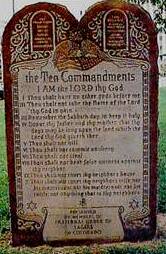
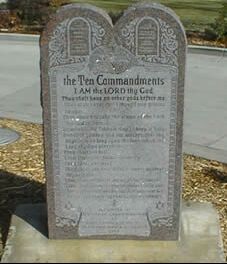
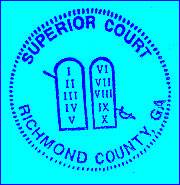
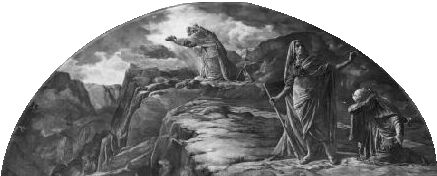
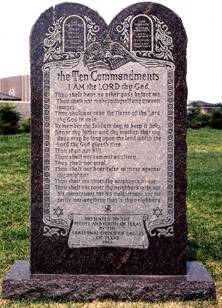
Copyright 2003 by DS Gands, ALL RIGHTS RESERVED
D.S. Gands is a freelance writer living in North Texas. The opinions of this article do not necessarily reflect the perspectives of this publication. If you would like to see this or other articles by D.S. Gands appear in your favorite publication, ask the editor to contact editor@ntxe-news.com regarding available reprint or syndication rights.